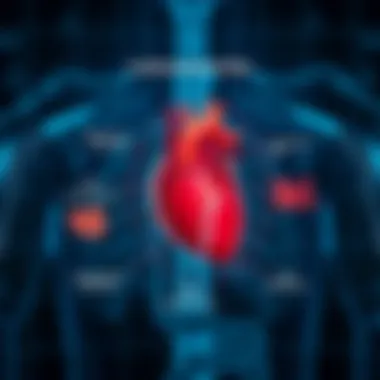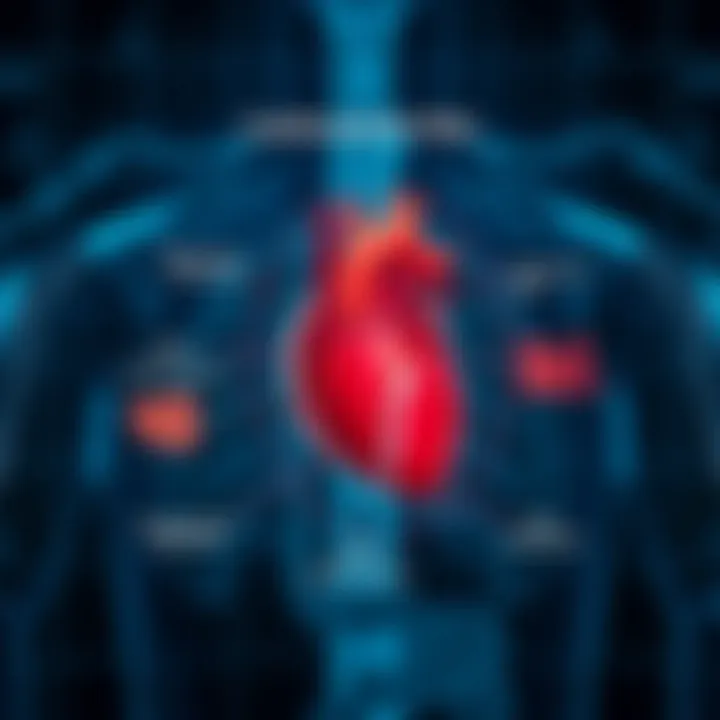Understanding HIV's Effects on Heart Health


Intro
HIV, or Human Immunodeficiency Virus, is often at the forefront of discussions concerning immune system health and infectious diseases. However, its impact stretches far beyond the immune system, affecting various organs and systems in the body, particularly the cardiovascular system. As our understanding of this relationship expands, it’s vital to explore how HIV influences heart health, the cardiovascular risks associated with the virus, and the implications this has for treatment and patient care.
This article delves into the nuanced connections between HIV and cardiovascular conditions, moving beyond the familiar narrative of AIDS-related complications. Through the lens of emerging research, we can glean insights into why individuals living with HIV may face heightened cardiometabolic risks.
Understanding these complexities is essential for healthcare providers, researchers, and patients alike as they navigate the terrain of HIV treatment and holistic health management. For many, the discussions surrounding HIV might be primarily about viral loads and CD4 counts, yet as data accumulates, the cardiovascular narrative grows equally imperative to address.
The following sections break down key findings, methodologies employed in various studies, and a detailed analysis of the interplay between HIV and cardiovascular health, emphasizing the crucial need for integrated care approaches.
In this exploration, we aim to clarify misconceptions, synthesize current research, and ultimately underscore the significance of vigilant monitoring and preventive care in those living with HIV.
Understanding HIV
HIV, or Human Immunodeficiency Virus, poses a significant public health concern, one that extends far beyond its immediate impact on the immune system. Understanding HIV is crucial in elucidating how this virus can influence overall health, especially regarding cardiovascular conditions. As the epidemic of HIV continues, researchers and healthcare professionals are increasingly recognizing the interplay between HIV and cardiovascular health. By comprehending the biology of HIV, transmission methods, and the consequent disease progression, we can appreciate the potential cardiovascular risks that are often overshadowed by more prominent aspects of HIV.
Grasping the nuances of HIV is not merely an academic endeavor. It's about enabling informed discussions around preventative measures, treatment options, and patient management. The complex relationship between HIV infection and heart health underscores the need for multidisciplinary approaches in healthcare, where both HIV management and cardiovascular care are integrated. This integration improves outcomes for individuals living with HIV, facilitating a comprehensive understanding of their health as a whole.
The Basics of HIV Biology
HIV primarily targets the body's immune system, specifically the CD4+ T cells, which play a pivotal role in immune response. The virus attaches itself to these cells, integrates its genetic material, and ultimately leads to cell destruction. This process weakens the immune system over time, making individuals more susceptible to opportunistic infections and other health complications. The life cycle of HIV consists of several stages: entry, replication, and release. During these phases, HIV is not only compromising the immune function but also potentially initiating harmful processes like chronic inflammation.
Understanding these biological underpinnings is critical, as they provide a foundation for grasping how HIV can lead to cardiovascular challenges. The cellular mechanisms that govern HIV's interaction with the immune system can also influence other bodily systems, including the cardiovascular system.
Transmission Pathways
HIV is transmitted through specific body fluids: blood, semen, vaginal fluids, rectal fluids, and breast milk. Common modes of transmission include unprotected sexual contact, sharing needles, and mother-to-child transmission during childbirth or breastfeeding.
Unlike some infections, HIV transmission requires substantial exposure to these fluids. For example, casual contact, such as hugging or sharing food, does not carry a risk of transmission. Furthermore, preventive measures, notably the use of condoms and pre-exposure prophylaxis (PrEP), can significantly reduce the likelihood of contracting the virus. Understanding these pathways not only aids in prevention but also in educating at-risk populations and spreading awareness about HIV.
In some cases, stigma surrounding HIV leads to misconceptions about how it spreads, which can further complicate prevention efforts. Public health initiatives that focus on clear communication and education are essential in addressing these stigmas and enhancing awareness.
Progression of HIV Infection
The progression of HIV infection occurs in several stages, generally categorized into acute infection, clinical latency, and AIDS. During the acute phase, individuals may experience flu-like symptoms, which can sometimes be mistaken for common illnesses. This stage is when the virus replicates rapidly and spreads throughout the body.
Following the acute stage, the clinical latency period may last several years. In this phase, the virus is still active but reproduces at very low levels. People may not exhibit any symptoms, which can lead to a false sense of security. Without treatment, this phase eventually leads to the progression into AIDS, where the immune system is significantly compromised, and the risk for various opportunistic infections, including those affecting the cardiovascular system, increases dramatically.
This understanding of disease progression is vital, as it emphasizes the importance of early diagnosis and regular monitoring. Individuals living with HIV who are effectively managed through antiretroviral therapy can lead longer, healthier lives while minimizing the risk of cardiovascular complications.
"A thorough understanding of HIV can empower individuals and pave the way for proactive management of health, reducing the burden of comorbidity like cardiovascular disease."
By delving into these elements, we set a strong foundation for discussing how HIV intricately weaves into cardiovascular health, shaping the clinical landscape surrounding both prevention and intervention.
Cardiovascular System Overview
Understanding the cardiovascular system's structure and function is essential for recognizing its vulnerabilities, particularly in individuals living with HIV. This section sheds light on the key components of cardiovascular health, which serves as a foundation for exploring how HIV impacts this vital system. Maintaining a healthy cardiovascular system is not just about avoiding heart disease; it can also significantly affect overall wellness, energy levels, and quality of life. The intricate relationship between multiple physiological systems means that any disruption, like that seen in HIV infection, can have far-reaching effects.
Anatomy of the Cardiovascular System


The cardiovascular system is a remarkable network that consists of the heart, blood vessels, and blood itself. This system is responsible for transporting essential nutrients and oxygen to tissues while removing waste products. To break it down:
- Heart: The heart is a muscular organ with four chambers: the right atrium, right ventricle, left atrium, and left ventricle. Each chamber plays a role in circulating blood throughout the body. The right side receives deoxygenated blood from the body and pumps it to the lungs for oxygenation. The left side does the opposite, receiving oxygenated blood from the lungs and distributing it to the rest of the body.
- Blood Vessels: These include arteries, veins, and capillaries. Arteries carry oxygen-rich blood away from the heart, while veins return oxygen-poor blood back to the heart. Capillaries, the smallest blood vessels, allow for the exchange of gases, nutrients, and waste between blood and body tissues.
- Blood: Comprising red blood cells, white blood cells, platelets, and plasma, blood not only transports oxygen and nutrients but also plays a crucial role in immune response and clotting.
Understanding the anatomy of the cardiovascular system highlights its complex functions and the potential implications of any associated diseases or infections.
Function and Regulation of Cardiovascular Health
The cardiovascular system functions as a finely tuned machine, working continuously to regulate blood circulation, manage blood pressure, and ensure that the body receives adequate oxygen and nutrients. Several key mechanisms influence cardiovascular health:
- Heart Rate Regulation: The heart adjusts its rate based on the body’s demands, such as during exercise or rest. This adaptability is essential for maintaining homeostasis.
- Vascular Tone: Blood vessels can constrict or dilate in response to various signals from hormones or the nervous system, which helps regulate blood pressure and blood flow.
- Blood Pressure Control: Blood pressure is influenced by heart rate, blood volume, and the constriction or dilation of blood vessels. The body continuously monitors and adjusts these levels to ensure adequate circulation without damaging the vessels.
- Hormonal Influences: Hormones such as adrenaline can affect heart rate and vascular resistance, playing a critical role in the body’s response to stress or activity.
The heart's and blood vessels' ability to adapt and respond to changing conditions is vital. However, the presence of HIV can disrupt these mechanisms, leading to various cardiovascular complications. Understanding these dynamics sets the stage for discussing how HIV influences cardiovascular health, underlining the need for targeted monitoring and interventions.
HIV and Cardiovascular Health
The relationship between HIV and cardiovascular health is a topic that has gained traction in recent years, prompting researchers and healthcare providers alike to pay closer attention to the often quiet yet profound impact this virus can have on the heart. Understanding these interactions is crucial not only for improving patient outcomes but also for developing specialized care strategies that take into account the unique health profiles of individuals living with HIV.
By examining specific elements of how HIV influences cardiovascular health, the discussion can highlight two things: the increased risk factors that HIV-positive individuals face and the intricate biological processes driven by the virus.
Several studies indicate that people living with HIV are at a higher risk for cardiovascular diseases, with mechanisms rooted in immune response alterations, persistent inflammation, and metabolic shifts. Factors such as these not only elevate the probability of heart disease developing but can also exacerbate existing conditions.
Mechanisms Linking HIV to Cardiovascular Disease
Understanding the mechanisms through which HIV contributes to cardiovascular disease requires a look into how the virus affects the immune system and subsequently, cardiovascular function. One principal mechanism involves the persistently elevated inflammatory markers commonly seen in HIV-infected individuals. This chronic inflammation can lead to vascular dysfunction, promoting the development of atherosclerosis—essentially the hardening and narrowing of arteries due to plaque build-up.
Moreover, the effects of HIV are not just limited to direct viral action; they also include shifts in cholesterol metabolism and blood vessel health. HIV is observed to induce changes in lipid profiles, often resulting in higher levels of triglycerides and lower levels of good cholesterol, or HDL. Such imbalances can enhance the risk of plaque formation, creating a perfect storm for cardiovascular complications.
In this context, the effects can be measurable. Studies have shown that HIV-positive individuals might experience elevated rates of heart attacks and strokes compared to their HIV-negative peers. As such, it becomes ever more necessary for healthcare providers to screen for cardiovascular disease in this population actively.
Inflammatory Response in HIV Infection
The inflammatory response elicited by HIV is another critical factor that shed light onto the connection between the virus and cardiovascular health. HIV infection initiates a robust immune response, leading to an increase in several pro-inflammatory cytokines and other markers that can have far-reaching effects on cardiovascular health. This chronic state of inflammation does not only affect heart health but can also contribute to other systemic issues.
What happens is that the body, in its fight against the virus, essentially puts the cardiovascular system under duress. The response can affect the rhythm of the heart as well, creating arrhythmias and other complications that further complicate health outcomes for those living with the virus. In essence, it’s as if the body is in a perpetual state of emergency, which over time, wears on the circulatory system.
"Chronic inflammation induced by HIV infection can lead to increased vascular stiffness and accelerated atherosclerosis, positioning affected individuals at heightened risk for serious cardiac events."
Given these details, understanding the inflammatory processes at work in HIV-infected individuals will not only guide treatment options but may also lead to more targeted interventions aimed at cardiovascular health. Simplistically put, it's about seeing the whole picture—treating HIV isn't just about managing the viral load; it's about the broader implications for the heart and vascular system.
Cardiovascular Risks in HIV Patients
Understanding cardiovascular risks in HIV patients is crucial, as it serves as a foundation for providing better health outcomes. People living with HIV face heightened risks not only because of the virus itself, but also due to the interplay of numerous factors such as lifestyle choices, opportunistic infections, and the effects of antiretroviral therapy. Addressing cardiovascular health in this population can dramatically influence their quality of life and longevity.
Increased Incidence of Heart Disease
The link between HIV and heart disease is quite alarming. Research indicates that individuals with HIV have a twofold increased risk of developing heart disease compared to those who do not have the virus. A significant contributor to this phenomenon is chronic inflammation induced by HIV itself. This inflammation can damage blood vessels, leading to atherosclerosis—all without the patient truly realizing the gradual decline their cardiovascular health is undergoing.
Moreover, some studies reveal that young adults living with HIV are experiencing heart problems that were previously observed mainly in older populations. This trend is unsettling, as it suggests that HIV is not just a concern for older adults but poses a genuine risk across the human lifespan. High rates of heart disease in patients with a well-managed viral load raise questions about the long-term implications associated with living with HIV. The interplay of factors complicates things, including comorbid conditions such as diabetes and hypertension, which often accompany HIV.
Impact on Blood Pressure and Lipid Profiles


Blood pressure irregularities and lipid profile disturbanaces are common among individuals living with HIV. Studies have indicated that these patients encounter elevated blood pressure levels more frequently than their non-HIV counterparts. It can be a double-edged sword. On one hand, the effects of HIV can lead to increased blood pressure levels and, on the other hand, many antiretroviral therapies can further exacerbate this issue.
On the lipid side of things, patients commonly display abnormal lipid levels, which can predispose them to heart disease. Specifically, people living with HIV have a tendency to develop dyslipidemia, characterized by elevated triglycerides and reduced HDL (the so-called 'good cholesterol'). The reasons for this distortion can be linked to the virus itself, but also to the medications used to treat it.
"A well-rounded approach to managing cardiovascular health in HIV patients is vital, necessitating regular monitoring and modification of lifestyle factors."
With the understanding of these cardiovascular risks, healthcare providers must incorporate routine cardiovascular assessments into HIV care plans. By proactively managing these risks, the healthcare community can help mitigate potential health issues, ultimately improving the lives of those affected.
Additionally, healthcare strategies addressing these concerns should not overlook the importance of encouraging lifestyle changes—like improved nutrition, regular exercise, and smoking cessation—which can contribute significantly to reducing cardiovascular complications in this vulnerable population.
For more detailed insights, you might want to explore additional resources like CDC, NIH or WebMD. Conclusively, understanding and addressing cardiovascular risks in HIV patients should not just be an afterthought; it needs to be a central part of treatment protocols.
Antiretroviral Therapy and Cardiovascular Implications
Antiretroviral therapy (ART) has transformed the landscape of HIV treatment, enabling patients to live longer and healthier lives. However, while ART effectively manages the viral load, its implications for cardiovascular health are complex and multifaceted. Understanding these complexities is paramount for healthcare providers and researchers alike, as the intersection of ART and cardiovascular health can influence treatment strategies and risk management in HIV-infected individuals.
Effect of Treatments on Cardiovascular Risk
The relationship between ART and cardiovascular risk is a topic of ongoing research, and it presents a double-edged sword. On one side, ART is crucial for viral suppression, significantly reducing the risk of AIDS-related illnesses and improving overall health outcomes.
Yet, some antiretroviral drugs have been associated with adverse cardiovascular effects. For instance, certain protease inhibitors, like Ritonavir and Lopinavir, have shown a tendency to elevate lipid levels, thus potentially increasing the risk for cardiovascular issues. Elevated triglycerides and LDL cholesterol levels can, in turn, set the stage for a heart attack or stroke over time. This situation calls for careful monitoring and management of lipid profiles in patients undergoing ART.
Conversely, newer classes of ART, such as integrase inhibitors, may pose less risk to cardiovascular health, highlighting the importance of individualized treatment plans. By selecting therapies with a favorable cardiovascular profile, healthcare providers can optimize patient outcomes, balancing the benefits of HIV suppression against potential cardiovascular risks.
"Managing HIV is not only about controlling the virus but also understanding the broader implications for health, including heart health."
This complex interplay necessitates an ongoing dialogue between patients and healthcare providers, ensuring that all facets of an individual’s health are considered in treatment planning.
Long-term Considerations of Therapy
As patients live longer with HIV due to effective ART, the long-term cardiovascular implications of their treatment regimens become increasingly important. Studies suggest that HIV itself may contribute to cardiovascular disease, but the effects of long-term ART on heart health are still being explored.
Persistent inflammation and immune activation linked to chronic HIV infection can exacerbate cardiovascular problems, even in patients with viral load suppression. Therefore, long-term ART users might face heightened risk due not solely to their medication but also the underlying effects of the virus itself.
Healthcare providers should implement regular cardiovascular screenings for HIV patients undergoing ART. This proactive approach helps identify risk factors early, ultimately enabling earlier intervention to mitigate potential complications.
In addition, long-term ART adherence can impact the overall side effect profile. Ensuring that patients remain on their treatment regimen while addressing any side effects—whether they're metabolic or psychological—is critical. Integrated care approaches that involve both HIV specialists and cardiology teams can be essential to navigate these challenges effectively.
Regular education about potential side effects, lifestyle modifications, and the importance of maintaining cardiovascular health can empower patients, allowing them to play an active role in managing their health.
It’s clear that ongoing research is necessary to fully grasp the long-term effects of ART on cardiovascular health. Studies investigating various ART regimens will continue to play a crucial role in developing guidelines that enhance both HIV management and cardiovascular safety for patients.
Clinical Implications and Management
Understanding the impact of HIV on cardiovascular health goes beyond theoretical discussions; it directly influences clinical practice and patient management. Addressing cardiovascular risks associated with HIV is essential, as patients with this virus face heightened susceptibility to heart-related complications. Thus, a comprehensive approach is indispensable for both preventative and therapeutic measures.
Effective management strategies include proactive screening and tailored interventions that recognize the unique cardiovascular challenges faced by HIV-positive individuals. It is not just about treating HIV; managing cardiovascular health transforms how healthcare providers engage with these patients.
Screening for Cardiovascular Risk in HIV Patients
Routine screenings for cardiovascular risk factors in individuals with HIV can significantly alter clinical outcomes. These patients, often overlooked, may not display obvious symptoms of cardiovascular disease, which can lead to late diagnoses. Health professionals should utilize multiple strategies for screening, including:


- Regular assessment of blood pressure and lipid levels: Monitoring cholesterol levels and blood pressure can identify individuals at risk before symptoms occur.
- Utilization of advanced imaging techniques: Methods like echocardiography or stress tests can provide insights into heart function and circulation.
- Monitoring HIV-related inflammation markers: This involves checking for inflammatory cytokines that may affect cardiovascular health despite antiviral success.
"Early detection and tailored interventions can reduce the incidence of cardiovascular diseases in HIV patients."
While these strategies are vital, it’s important to ensure patients understand their own cardiovascular risks as well, empowering them to make informed choices. Education and engagement can foster a proactive attitude towards health, potentially improving adherence to both HIV treatment and cardiovascular care.
Strategies for Preventing Cardiovascular Disease
Preventive strategies form the backbone of effective management for cardiovascular issues related to HIV. Implementing a holistic approach can go a long way in reducing the long-term risks associated with the virus. Here are some effective actions:
- Encouraging lifestyle modifications: Patients should be motivated to engage in regular exercise, maintain a balanced diet, and avoid smoking, all of which can positively influence heart health.
- Tailored pharmacological approaches: Utilizing medications like statins to manage lipid levels, particularly in patients with higher cardiovascular risk scores, represents a proactive measure to prevent heart disease.
- Integrating mental health support: Addressing mental well-being is vital, as stress and depression can further compound cardiovascular risks in HIV patients. Providing access to psychological services might improve overall health outcomes.
- Coordination across specialties: Collaboration between primary care providers, cardiologists, and infectious disease specialists can enhance patient care. Having a united front allows for streamlined communication on treatment progress and cardiovascular health.
Through these comprehensive strategies, healthcare providers can implement a multi-dimensional approach to managing cardiovascular health in HIV patients, acknowledging that optimal health encompasses more than just HIV suppression.
For additional resources, consider visiting:
- HIV/AIDS and Cardiovascular Disease - CDC
- American Heart Association's Policy on HIV and Heart Disease
- National Institutes of Health HIV and Heart Disease Research
Research and Future Directions
Understanding the intersection of HIV and cardiovascular health is still an evolving field. Research in this area is crucial. It holds the promise of revealing how HIV impacts heart health and informs clinical practices. As we peel back the layers, we see more connections between the virus and various heart conditions. The focus on research and future directions allows for better preventative measures, treatment options, and ultimately improved patient outcomes.
Current Research Trends on HIV and Heart Health
In recent years, a plethora of studies has emerged, highlighting the link between HIV and cardiovascular diseases. Understanding these trends allows researchers and practitioners to refine strategies for managing cardiovascular health in HIV patients. Here are some notable areas of focus:
- Inflammatory Mechanisms: Ongoing research digs deep into how chronic inflammation caused by HIV can lead to vascular damage. This understanding can pave the way for targeted therapies that address these inflammatory processes.
- Comorbidities: Researchers are also looking into how HIV interacts with other conditions like diabetes and hypertension to exacerbate cardiovascular risks. This multi-faceted view is vital because it underscores the importance of managing comorbidities alongside HIV treatment.
- Biomarkers: Investigating novel biomarkers that predict cardiovascular risk in HIV-positive individuals could help tailor preventative measures. Biomarkers may offer insights that traditional methods overlook.
"The link between HIV and heart disease is more than meets the eye; ongoing research is vital for revealing these hidden connections."
By keeping these areas in focus, the medical community can design individualized care plans that align with the specific health needs of each patient.
Promising Strategies in Cardiovascular Research
As researchers chart the course ahead, several innovative strategies are emerging that could significantly impact the landscape of cardiovascular care for HIV patients. A few noteworthy strategies include:
- Integrated Care Models: There's a growing push for integrated care approaches that combine HIV treatment with cardiovascular health management. These models aim to create a seamless experience for patients, improving adherence and health outcomes.
- Lifestyle Interventions: Evidence suggests that lifestyle changes can have a profound impact on cardiovascular health in HIV patients. Initiatives that encourage healthy eating, regular physical activity, and smoking cessation are gaining traction.
- Pharmacological Advances: New medications are being developed that not only target HIV but also address cardiovascular risks. The dual-action nature of these new therapies could provide significant advantages over traditional treatments.
- Personalized Medicine: In line with broader trends in healthcare, personalized medicine approaches that take individual genetics and health history into account are becoming increasingly important. This focus holds promise for optimizing treatment plans.
The focus on these innovative strategies is essential for reframing how we manage cardiovascular health in individuals living with HIV, ensuring that they receive holistic and attentive care.
The End
In the landscape of health care, understanding the intersection between HIV and cardiovascular health is not just beneficial, it's essential. This article’s exploration into how HIV influences heart health showcases the intricacies of this relationship. Recognizing how the virus alters cardiovascular dynamics can ultimately mitigate long-term health risks.
Summary of Key Findings
The journey through the article underpins several critical insights:
- Increased Cardiovascular Risks: Individuals living with HIV face a higher chance of developing various heart diseases. Studies reveal the rate of heart issues can be significantly higher compared to the general population.
- Inflammatory Mechanisms: One of the takeaways is the role of inflammatory processes activated by HIV. The virus promotes systemic inflammation, which can lead to atherosclerosis and other complications related to the cardiovascular system.
- Antiretroviral Therapy: While effective in managing HIV, certain antiretroviral medications may contribute to cardiovascular risk factors, necessitating regular cardiovascular screening and management for those on treatment.
- Tailored Health Approaches: The importance of individualized care tailored to the unique needs of HIV-positive individuals is highlighted. Health care strategies must incorporate a multi-disciplinary approach to effectively manage both HIV and cardiovascular health.
The Importance of Integrated Health Approaches
Integrating cardiovascular care into routine HIV management stands out as a crucial element. The complexities inherent in patients' needs require a cohesive team that includes infectious disease specialists, cardiologists, and dieticians.
- Holistic Management: Addressing not just the HIV infection but also tackling lifestyle factors such as diet and exercise can play a huge role in mitigating risks.
- Regular Screenings: Setting up regular cardiovascular screenings for patients living with HIV can prevent or at least delay the onset of heart diseases, offering a safety net in this vulnerable population.
- Patient Education: Equipping patients with knowledge about their health risks can engage them more in proactive health decisions, encouraging adherence to lifestyle changes and treatment protocols.
By embedding these integrated approaches into health care practices, we move closer to more effective management of HIV patients and their cardiovascular concerns. The importance lies not just in treating the virus but in safeguarding overall health, ensuring a better quality of life.















